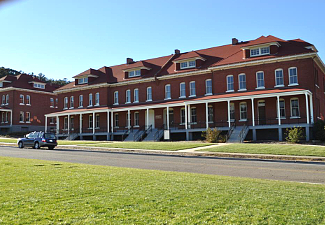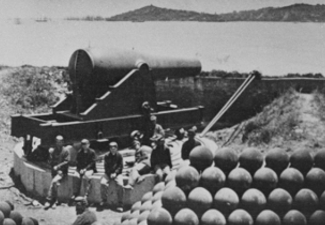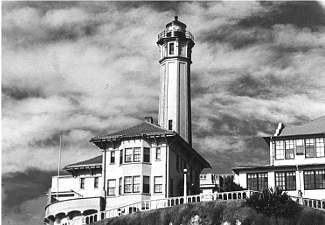
Photo above: 1895 view of Alcatraz from San Francisco Bay. Source: National Park Service. Right: Golden Gate Bridge from the north Point Lobos area of the National Recreation Area. Source: Wikipedia Commons.
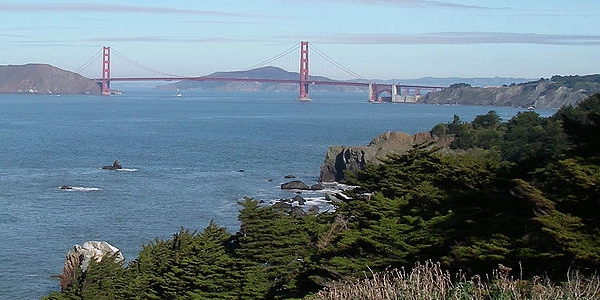
Golden Gate National Recreation Area
Boy, this park encompasses so much, it's a bit hard to describe, and certainly well attended, over twelve million people per year come to view that famous bridge from the many historic and natural sites that embrace the park from the confines of the city of San Francisco to the shores of the bay and ocean north and south. Yes, it claims stake, in some ways, to other monuments such as Muir Woods and Fort Point, but to us, they're separate, with the focus here on parks and forts that deserve mention on their own. The Presidio. Alcatraz. Fort Baker. Fort Mason. Marin Headlands. Point Bonita Lighthouse. Too many to mention in a summary. So much to see you'll need the better part of a week just to make headway. And much of the time, you'll get to see, through the fog or sun, that iconic bridge across the bay.
Click here to Sponsor the page and how to reserve your ad.

Golden Gate NRA Then
The Presidio - As the eastern seaboard engaged in the war of revolution, the Spanish came to the Presidio and established their northern garrison outpost on September 17, 1776, eventually replaced by Mexico after their independence in 1821. In 1846, settlers and Lt. Fremont crossed San Francisco Bay as part of the Bear Flag Revolt against Mexican rule and captured the Presidio without a fight. It would remain an Army post for one hundred and forty-eight years after that with a variety of tasks. One task would foreshadow its eventual use as a National Park when soldiers were asked to patrol newly minted Yosemite and Sequoia National Parks in the 1890s. It would be a center for troops going to the Spanish-American War, World War I, World War II, the Korean War, and Desert Storm. In between, part of its land would host the San Francisco World's Fair of 1915.
Cliff House and Sutro House - In the Land's End area of the park, real estate developers built a resort called Cliff House in 1863 overlooking Seal Rock. There had been a smaller first incarnation built five years before from a ship wrecked nearby. The original Cliff House lasted until 1891 when a fire destroyed it. The 1863 building was replaced by a much larger structure, an eight story castle in 1896; it was destroyed by fire in 1907. The next Cliff House, built of concrete in 1909, is still around today as a place to dine and watch the seals on Seal Rock. During the second Cliff House era, Arthur Sutro also built the Sutro baths in 1894. It was an ocean pool acquarium north of the house with a three acre bathhouse. The pools could accommodate 10,000 people at one time. The baths would decline in popularity, become an ice skating rink, then be sold for development that never came.
Island of Alcatraz - For most, they think of Alcatraz history as the prison, but its history traces much further back to its legacy as a military installation to protect the city of San Francisco. Beginning in 1850, under the direction of President Millard Fillmore, the island of the pelicans would become a place of protection. Work to fortify the island began in 1853; by 1858, it was Fortress Alcatraz with two hundred soldiers and eleven cannon. By 1868, its use was changed, now to house military prisoners, and it did so until it became a federal prison in 1934. It held one hundred and thirty-seven prisoners on its first day; over the next twenty-nine years, it would house Al Capone, Machine Gun Kelly, and Mickey Cohen.
Marin Headlands - For thousands of years, the Miwok indians moved on a seasonal migration from the bay to ocean side of the headlands. By the 1700's, the land of Marin had been transformed to Spanish, Mexican, and Portuguese dairy farms. Beginning in the 1890's, another transformation began, building military forts to prevent hostile ships from entering San Francisco Bay. Fort Baker (1872-1897), Fort Barry (1908), Fort Cronkhite (1930s), Fort Barry (1908), and the SF-88 Nike Missile site (1954) were among those constructed.
Photo above: Postcard of a morning military salute at the Presidio, 1915. Source: National Park Service. Below: The Golden Gate Bridge looming over the Old U.S. Coast Guard Station. Source: National Park Service/Will Elder from Wikipedia Commons.

Golden Gate NRA Now
To get an idea of just how encompassing this park is, take out the map from the park brochure and gander at its breadth. For many, it trails on the north side of the Golden Gate Bridge from the Muir Woods National Monument to Kirby Cove, but that's only the beginning. In the bay, you've got Alcatraz, in San Francisco proper, you have the Presidio, Land's End, and Ocean Beach. And to the deep south, the additions in San Mateo County that dip all the way down to Palo Alto. In all, you've got nature and city and forts that protected all, an iconic bridge to cross from one section to another, and so much history to learn amongst so much scenery, you might even fool the kids that they're learning something. Heck, you might even fool yourself.
The Presidio - Today you can walk or take the Presideo Shuttle around the historic buildings, eight hundred of them, of the Presidio, look at exhibits in the Visitor Center and the Officer's Club, as well as the Walt Disney Family Museum. You can also stay at the Inn at the Presidio, wander down to Crissy Field or over to Baker Beach. The remaining buildings are being restored and rehabbed into various commerical and residential enterprises.
Cliff House and the Sutro Baths - While the Cliff House remains as part of Golden Gate NRA with views of Seal Rock and dining, the Sutro Baths were destroyed while preparing for the development that never came. The ruins are now part of the park.
Alacatraz Island - Although the prison was closed in 1963, history continued to be made there when occupied by Indian tribes protesting federal treatment, and today, you can visit the many areas of the prison and other buildings.
Marin Headlands - Now home to the restoration of Fort Baker, the Point Bonita Lighthouse, Fort Cronkhite, as well as the Marin Headlands Visitor Center in the Fort Barry chapel.
Minute Walk in History - Golden Gate Bridge Construction
Take a tour back in time with this video and photos of the construction and opening, 1937, of the Golden Gate Bridge, which bridged the straight that allowed ships into San Francisco Bay from the Pacific Ocean. No longer would residents of the eastern side in Marin County have to ferry across to San Francisco.
T-Shirts and Souvenirs

Golden Gate National Recreation Area T-Shirts and Souvenirs from the official merchandise of America's Best History. Great for fans of San Francisco and California nature and history.
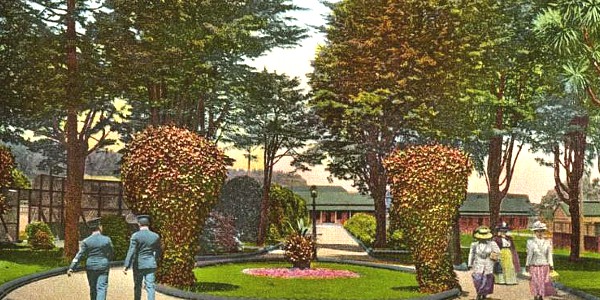
Golden Gate National Recreation Area
Things You Should Not Miss
1. Take in a meal in the current version of Cliff House and watch the seals at Seal Rock in the bay. Don't know why we liked watching the seals that much, but we did.
2. Yes, hitch a ferry ride over to Alcatraz and picture yourself housed on this island in three parts; as a soldier guarding the San Francisco Bay, as a guard guarding some of the most notorious prisoners of the day, and as an Indian protester, siezing the rock to make a point. This is a site you should not miss at Golden Gate NRA, because if you do, you'll be asked why by yourself and other again and again.
3. Head to the Presidio. Eight hundred buildings make up the site with a growing amount of interesting tenants; the National Park Service Visitor Center, Officer's Club, Walt Disney Family Museum, George Lucas Filmworks, and more on the way.
4. Find another fort of your choice to visit or visit them all. Fort Barry, Fort Baker, Fort Chronkhite, Fort Funston, Fort Point, Fort Mason, and Battery Chamberlin.
Photo above: Postcard of soldiers and ladies walking through the Presidio Grounds, 1918. Source: National Park Service.

Get Baseball History and Books at Stat Geek Baseball, including Baseballs Best.
Visitor FAQ



